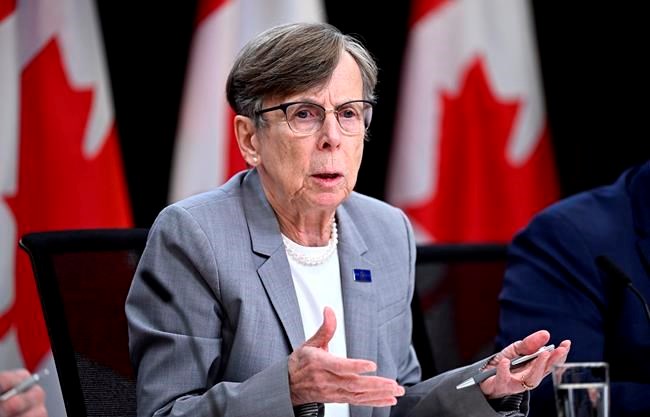OTTAWA — The Transportation Safety Board is calling for improvements to pilot training and aircraft equipment after an investigation into a deadly helicopter crash in Nunavut.
Pilots need better procedures and tools for flying in whiteout conditions, said safety board chairperson Kathy Fox.
"The safety deficiencies that we will highlight are not new," she said. "For more than 30 years, the TSB has been calling for the implementation of safety measures to mitigate the risks that persist in helicopter reduced-visibility operations.
"Enough lives have been lost."
On Thursday, the board released the results of its investigation into the crash of a helicopter about 20 kilometres southwest of Resolute Bay, Nvt. Two crew members and a wildlife biologist were killed returning from a camp studying polar bear populations.
The board reported that on the late afternoon of April 25, 2021, the helicopter owned by Yellowknife-based Great Slave Helicopters left a remote camp on Russell Island, where scientists had spent 12 days conducting polar bear research. The pilot hoped to avoid approaching blizzard conditions.
But as the helicopter flew over Griffith Island, the snow-covered terrain, overcast sky and a snow squall likely created flat light and a whiteout. The board said that caused the pilot, who was flying under visual flight rules, to lose visual references.
An "unintentional descent" caused the helicopter to crash and burn.
"The pilot’s limited experience operating above the tree line during the winter and spring months likely lowered his perception of risk, influencing the decision to continue flight over featureless snow-covered terrain under overcast skies and poor visibility," the report says.
"The pilot’s decision to depart was based on an incomplete understanding of the weather forecasted along the intended route."
The board made four recommendations to prevent such tragedies in the future.
It says regulations should be brought in to ensure pilots have adequate skills for flying in whiteouts; helicopters should have instrumentation to assist pilots in such weather; companies should develop operating procedures for poor conditions; and rules should be implemented for helicopter companies to ensure pilots have adequate protection for unexpected events.
"We're talking about training on flight instruments and (pilots) possessing the ability to revert to flight instruments in conditions when outside visual references are insufficient," said lead investigator Daryl Collins.
Collins said the board doesn't recommend specific safety technologies, but pointed out that radar altimeters, synthetic vision equipment and terrain awareness and warning systems are all available on the market.
"There are a number of forms of technology that could be used to assist a pilot," he said.
Bernard Gervais, executive director of the Northern Air Transport Association, which represents northern air carriers, called the board's recommendations "common sense."
"We're glad there may be some actions taken," he said.
He said his group hopes to be approached as Transport Canada decides what to do in response to the report.
"Transport (Canada) and our association put safety first."
The report says Great Slave Helicopters has taken a series of measures to improve safety, including changes to operating procedures in whiteouts. The company did not immediately respond to a request for a response to the report.
The board said loss of visual reference accidents are more than twice as likely to involve helicopters than airplanes, but requirements for visibility limits, aircraft equipment and pilot training are less stringent for helicopters than planes.
"These differences mean that helicopters may operate at half the visibility applicable to airplanes but without the same level of defences as airplane operations," it said.
Transport Canada did not immediately respond to a request for comment.
The board said there have been 13 investigations involving commercial helicopter flights between 2010 and 2018 in which pilots lost the sense of where they were.
Fox said some helicopter companies already operate in accordance with the board's recommendations. She said requiring all operators to do so would level the playing field in a competitive market and reduce compliance costs for everyone.
The U.S. already has such requirements, she said.
"Transport Canada and industry have taken some actions," Fox said. "(But) what our investigations have shown is that it's not working.
"We need to do more."
This report by The Canadian Press was first published Feb. 15, 2024.
— By Bob Weber in Edmonton
The Canadian Press
Note to readers: This is a corrected story. A previous version suggested the polar bear camp was on Griffith Island.



